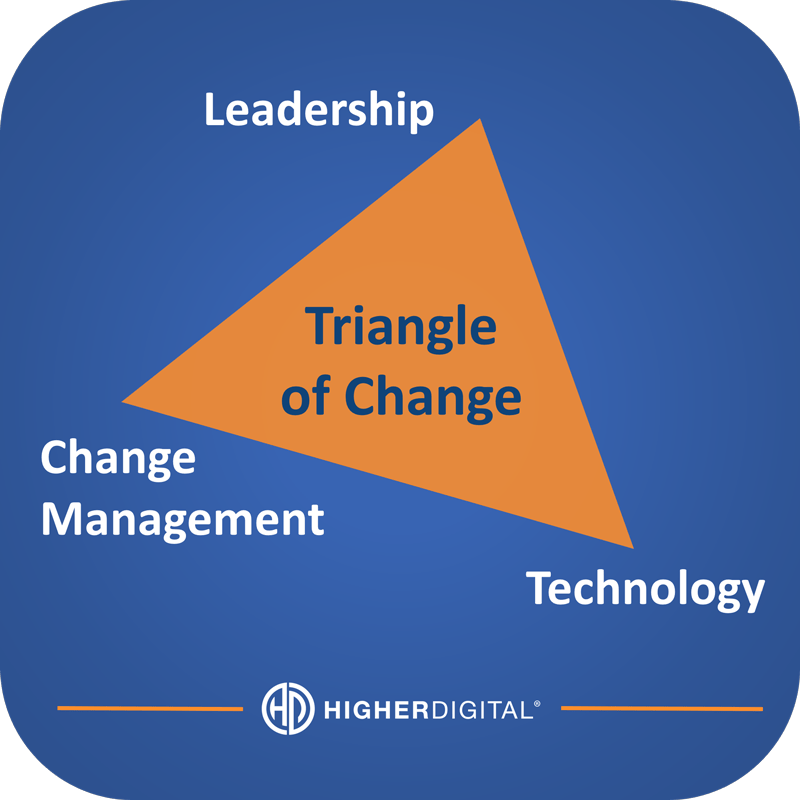BLOG
Triangulating Leadership, Change Management and Technology for Sustainable Digital Transformation
In today’s rapidly evolving higher ed landscape, successful, ongoing digital transformation is no longer just an option; it’s a necessity for institutions to remain competitive and relevant. However, embarking on this transformative journey requires more than “simply” implementing the latest technology. It demands a strategic alignment of leadership, change management, and technology—a synergy that forms a strong and dynamic “Triangle of Change.” As a form, the triangle has immense architectural strength; as a map for interactive perspective and motion, the triangle can help institutions reimagine the classic organizing principles of People/Process/Technology with a pivotal twist that we have seen leading to improved results.
The Triangle of Change concept really came into focus for me during my recent conversation with Andrea Ballinger – Vice Provost and Chief Information Officer at Oregon State University – in episode 52 of the transformed podcast, Empowering Digital Stakeholders. References to that conversation will help me further describe each of the three vertices of the Triangle of Change:
Vertex 1: Leadership (The Guidance)
Institutional leadership serves as the compass that steers the organization toward its overarching strategy, including digital transformation. Effective leadership involves not just setting visionary goals but also securing the necessary resources, prioritizing initiatives, and nurturing a culture that embraces change. By fostering a shared sense of purpose and commitment to change, leadership paves the way for revolutionary results over time.
At Oregon State University, the leadership team set a clear vision for a digital-first future and secured the funding necessary to support it. But while executing the plan, it became clear that student success objectives necessitated a new Customer Relationship Management (CRM) system, and this became the top priority. Effective governance and ongoing prioritization enabled transparent decision-making and ensured that the necessary people and resources were allocated to support the initiative.
Vertex 2: Change Management (The Adjustment)
Change management provides the bridge that connects people to processes. Effective institutions use change management to make the process adjustments needed to accomplish the objectives prioritized by leadership. The most effective institutions accomplish these adjustments through collaborative growth that respects and enhances the culture of the institution. This collaboration converts the power of change from a form that tends to produce fear into a form that produces engagement, achievement, and a sense of belonging.
During the shift in priorities, Ballinger recognized some limitations of her technology team and drew in specialists from the Finance & Administration team to provide their insights on forecasting and planning, ensuring their expertise was included while gaining their buy-in to the process and its outcomes.
Vertex 3: Technology (The Automation)
Technology serves as the catalyst that accelerates digital transformation by automating processes, augmenting capabilities, and delivering actionable insights. However, these benefits only accrue to those institutions that know how to extract them from an otherwise tangled web of choices. Once again, triangulation can help. By heeding ongoing guidance and prioritization supplied by leadership and helping people adapt to new processes using change management, technology can “slot in” to provide the magic of digital automation.
Ballinger discovered that OSU had 91 different CRM implementations! While this certainly helped make the economic case to move to one system, the process of moving meant that there 91 different CRMs to mourn while opening one’s mind to adopting a single cloud-based system that could not be customized (more on that choice in another blog ; ). This is where the triangle really shines: if leadership guidance is clear and you are able to adapt using good change management practices, you significantly improve your institution’s ability to partner with vendors and leverage their technology investment economies.
The Power of Triangulation
The Triangle of Change—where leadership, change management, and technology converge and adjust—offers a model that supports organizations through successful digital transformation. It’s more than just adopting the latest tech trends; it’s about orchestrating a holistic approach that interweaves people, processes, and technology in a synchronized symphony of change. By reimagining the traditional People/Process/Technology framework with a twist, institutions can navigate the complexities of digital transformation and emerge more aligned, more agile, and more accomplished.
So, as you embark on your own digital transformation journey, remember to embrace the power of triangulation—it’s your key to unlocking a future of endless possibilities.
I’m going to explore this Triangle of Change concept further in upcoming blogs and would love to get your perspective. Would you swap out one vertex for something else? Add another element to change the triangle to a square? Send me your thoughts and feedback at discussion@higher.digital.
